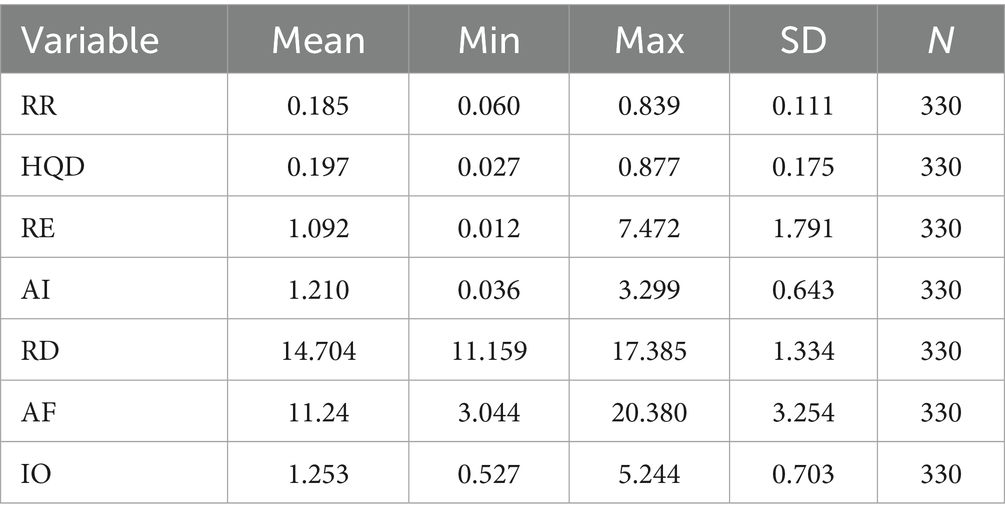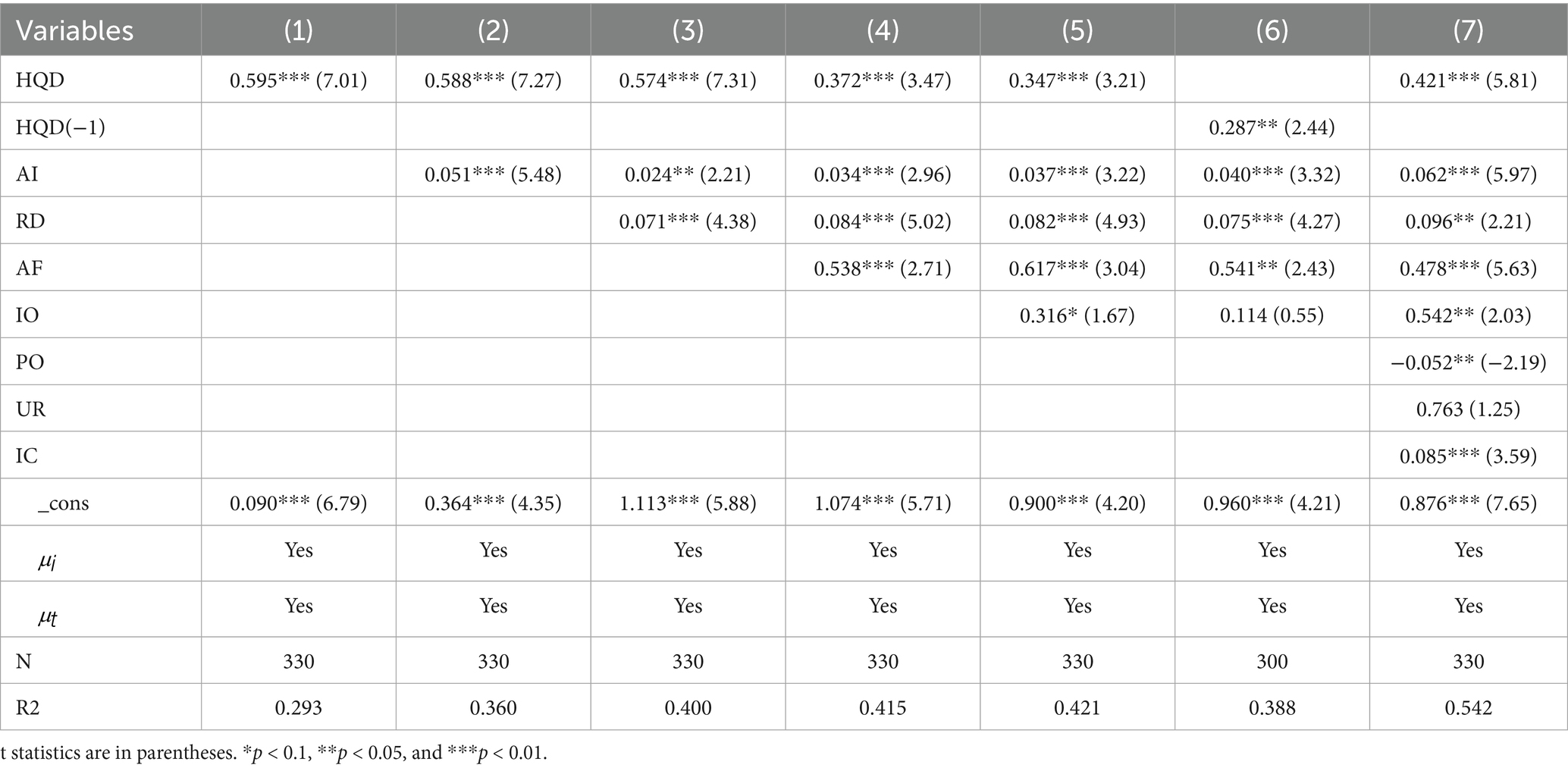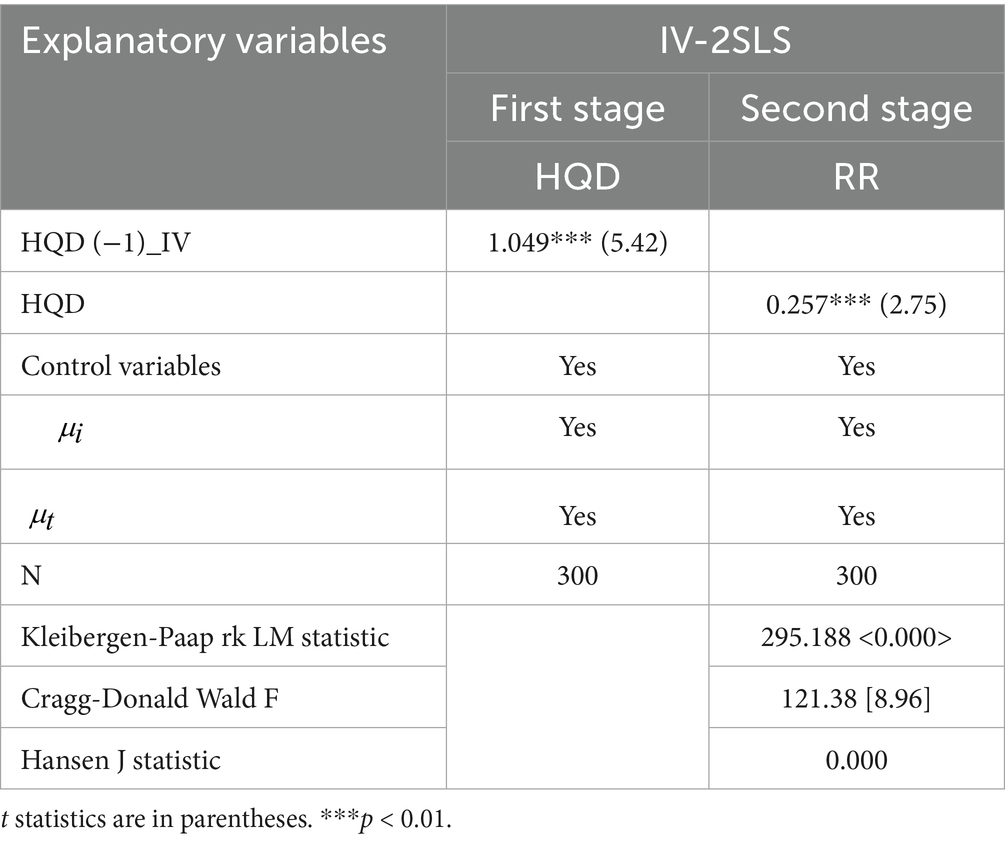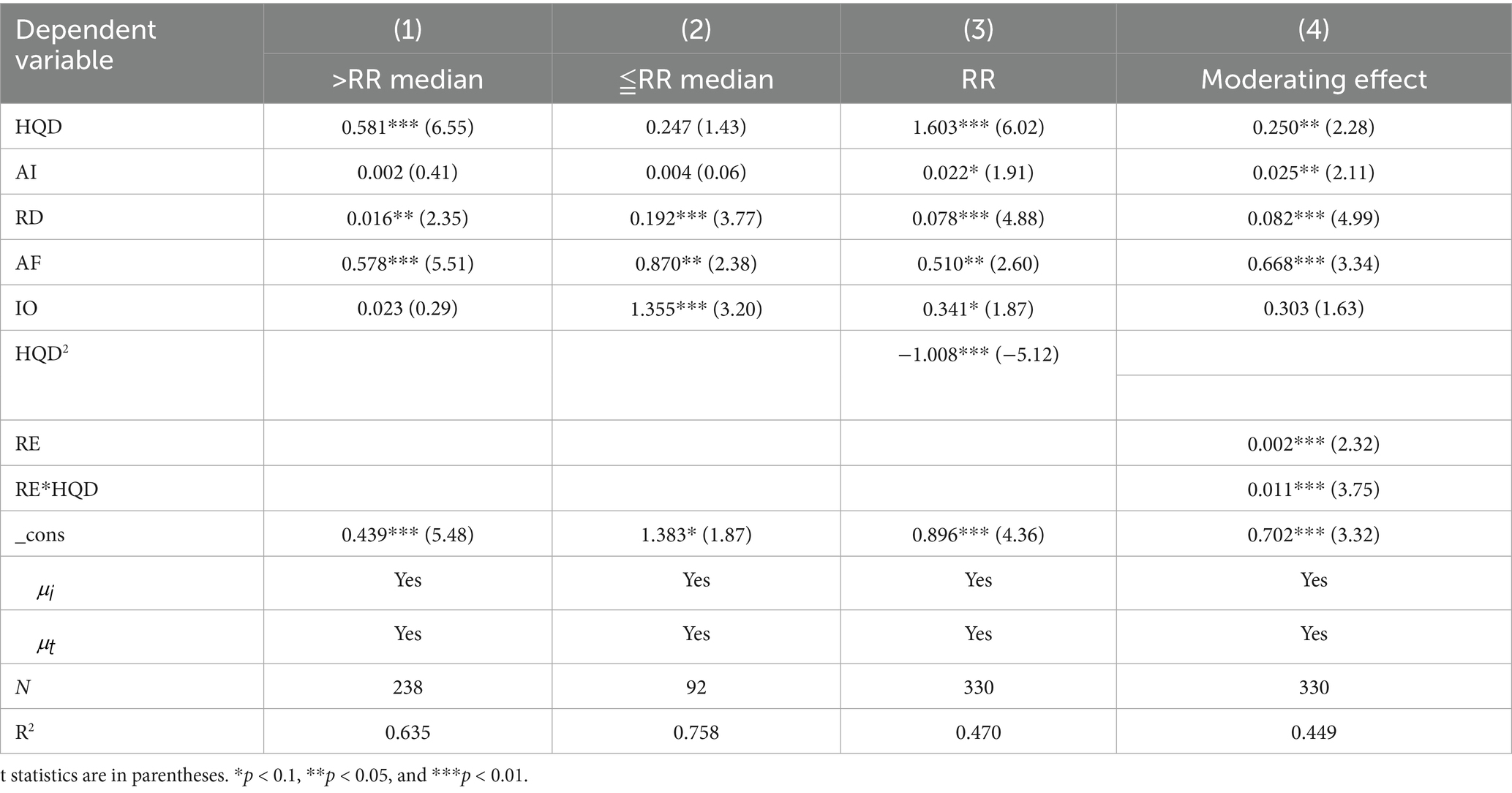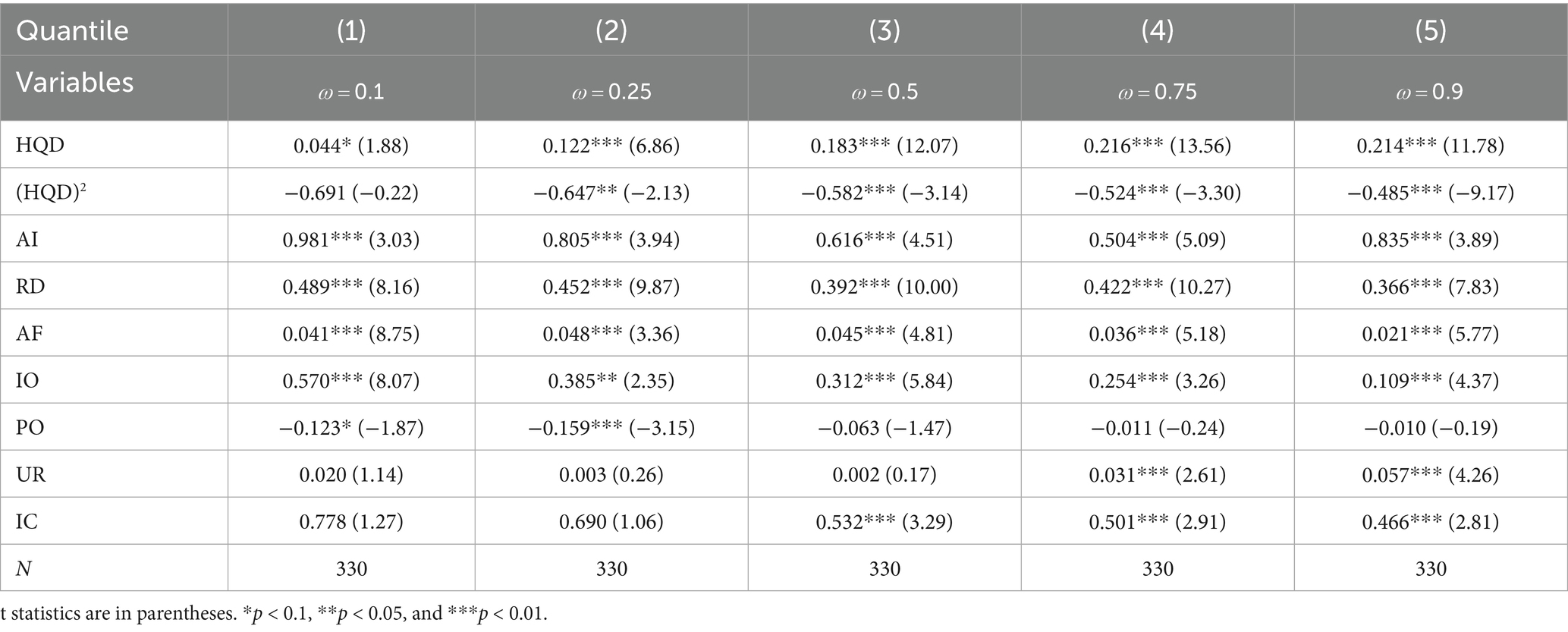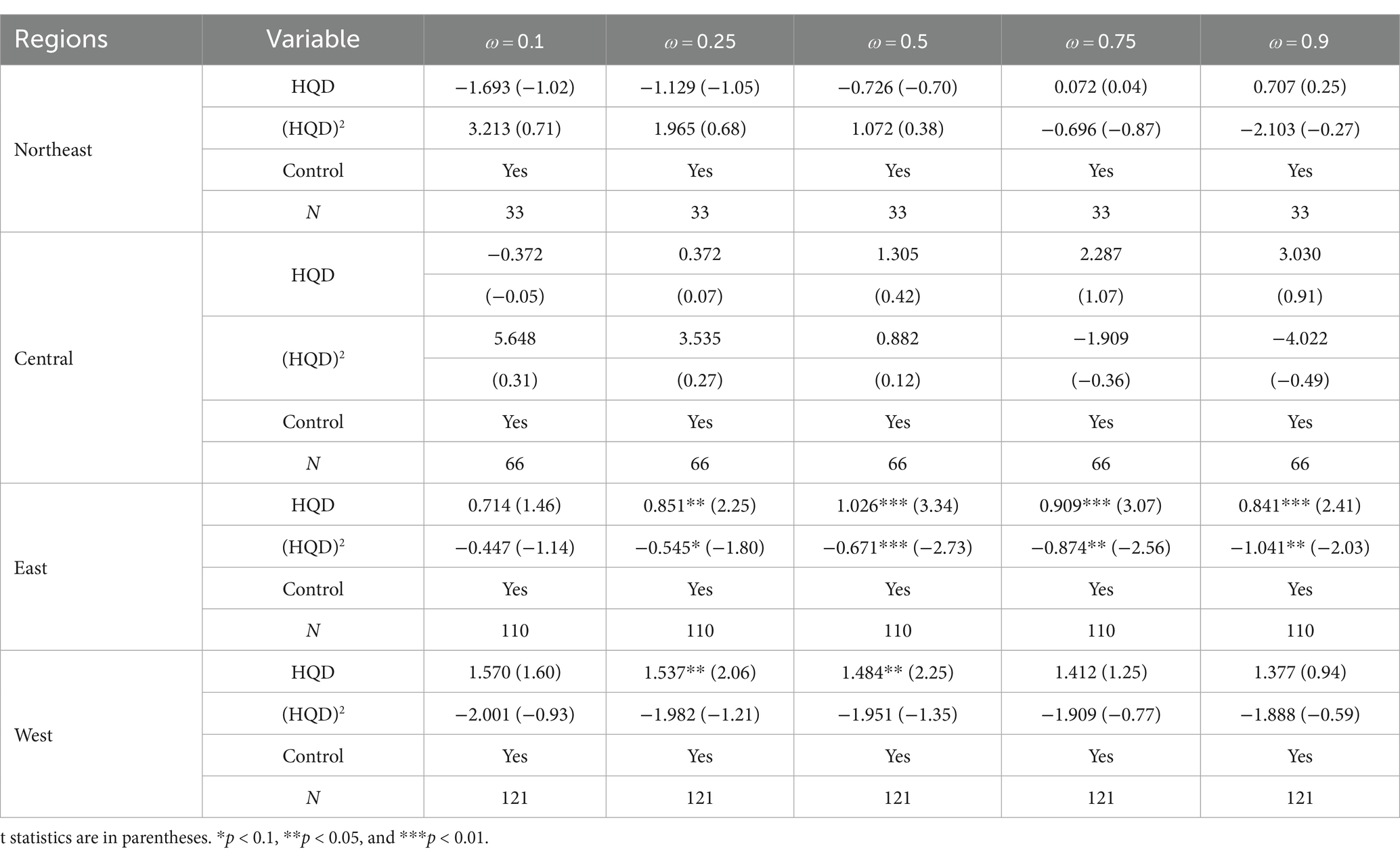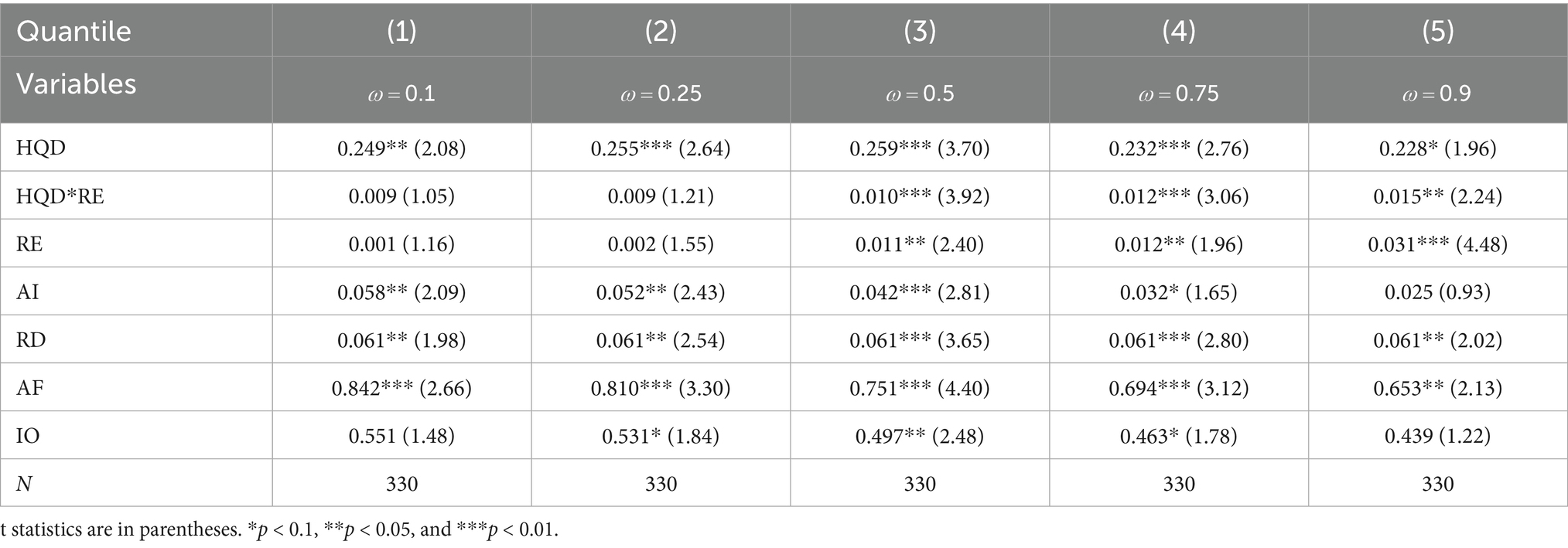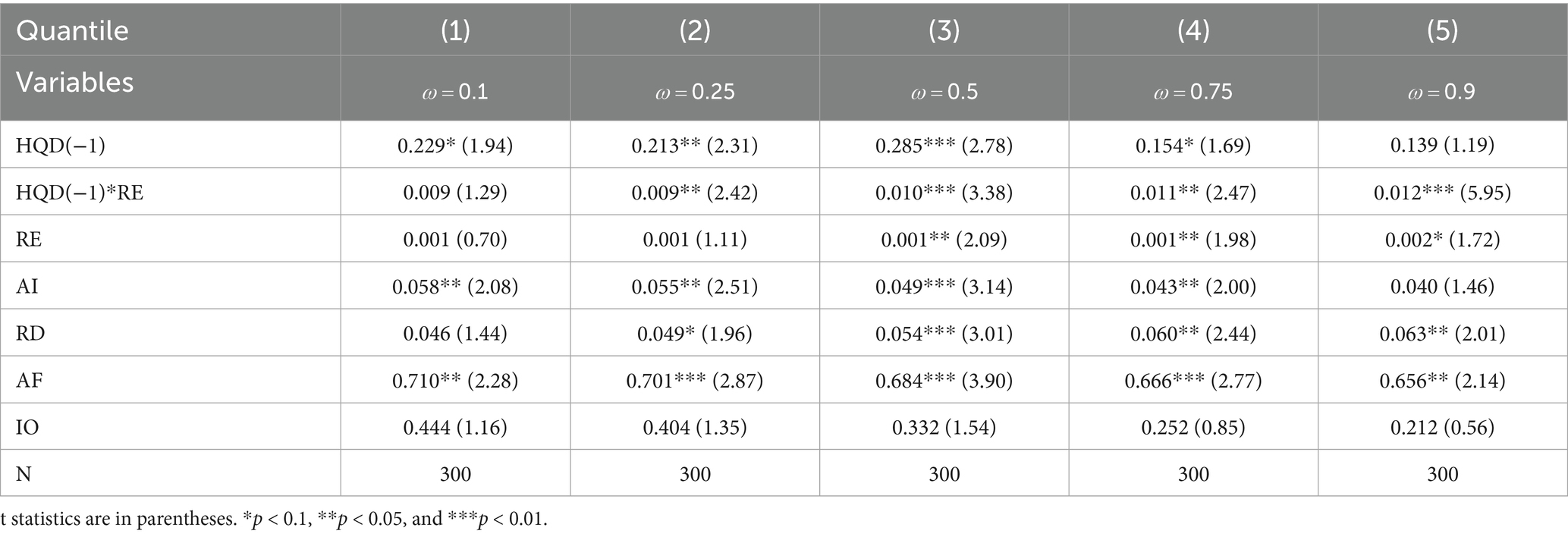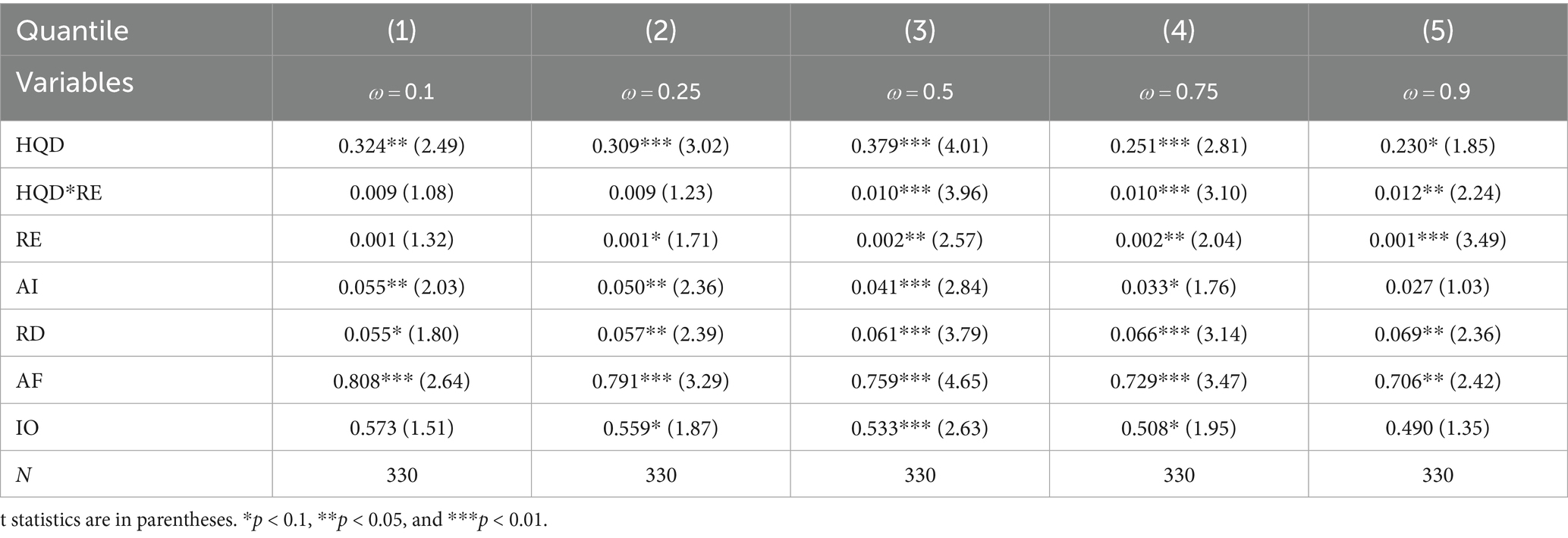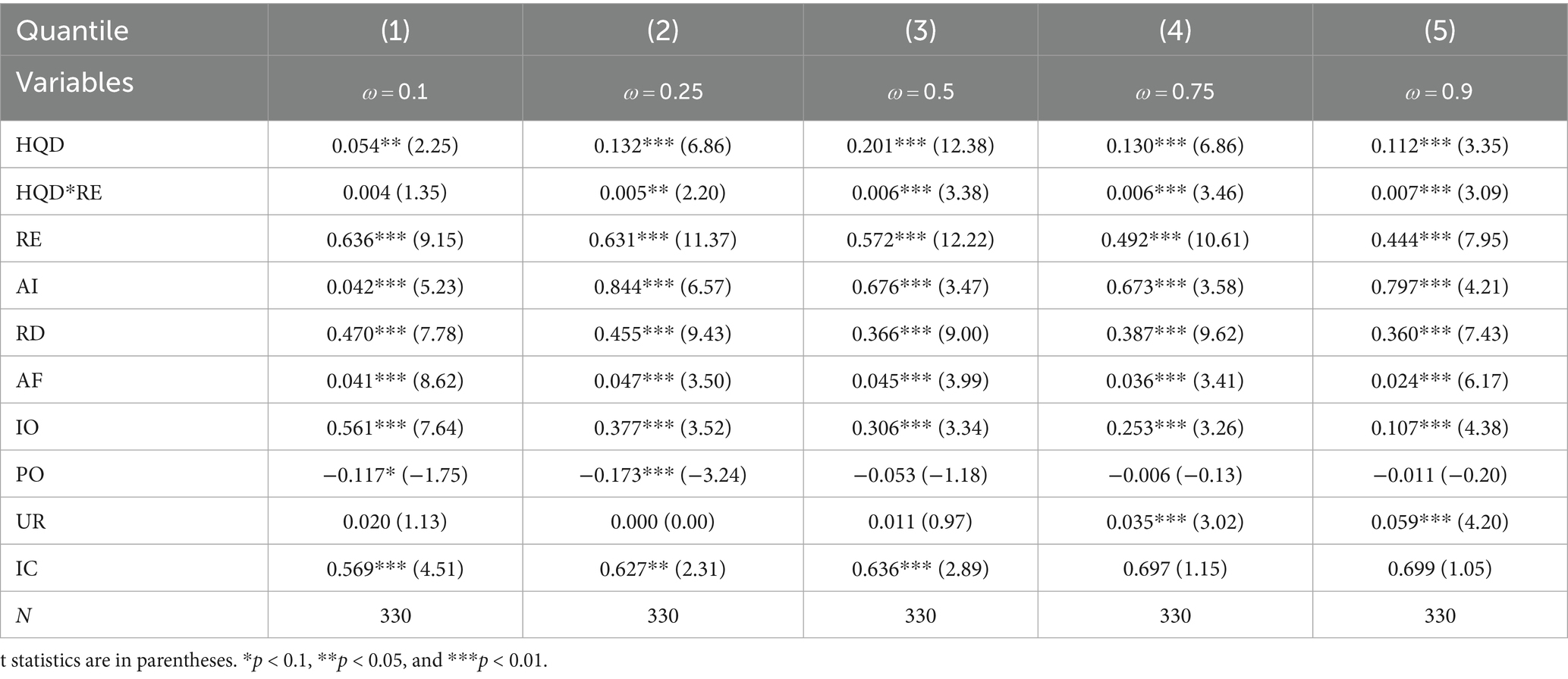- 1School of Journalism and Communication, Nanchang University, Nanchang, China
- 2School of Economics and Management, Nanchang University, Nanchang, China
Introduction: As a cornerstone of China’s modernization strategy, rural revitalization (RR) plays a critical role in addressing regional imbalances and promoting inclusive development. This study explores how high-quality development (HQD), a strategic priority aimed at sustainable and efficient growth, impacts RR, with a focus on the mediating role of rural e-commerce (RE).
Methods: Using Chinese provincial panel data from 2011 to 2021, this study applies a panel quantile regression model to capture the nonlinear relationship between HQD, RE, and RR. This approach allows us to examine heterogeneous effects across different levels of RR development and identify threshold effects where applicable.
Results: First, HQD exhibits an inverted U-shaped relationship with RR, peaking at the 50th quantile of the RR distribution. Beyond a threshold HQD index value of 0.795, the effect becomes negative, suggesting that excessive development intensity may undermine rural progress. Second, RE significantly enhances RR only in regions with medium-to-high RR levels, indicating that enabling conditions such as infrastructure and market access are prerequisites for e-commerce to drive rural transformation. Third, the threshold effect of HQD is primarily observed in eastern China, the Yangtze River Economic Belt, and economically developed regions, revealing notable heterogeneity.
Discussion: These findings highlight the importance of context-specific policy design in promoting sustainable rural development. The nonlinear impact of HQD suggests that overly aggressive development strategies may be counterproductive, particularly in less-developed rural areas. Moreover, the conditional role of RE underscores the need for targeted investments to build foundational capacities before e-commerce can effectively contribute to rural revitalization. The regional disparities identified call for differentiated governance approaches that align with local economic structures and developmental stages. Overall, this study provides an evidence-based framework to guide more effective and regionally tailored rural development policies under China’s broader high-quality development agenda.
1 Introduction
From the perspective of social development, the rapid expansion of cities and the relative decline of the countryside under the combined effect of urbanization and industrialization is a worldwide problem (Li et al., 2019; Xu et al., 2020). This trend was observed in developed countries such as the U.S. and Japan in the 20th century. In the second half of the 20th century, China saw a rapid increase in the urbanization process. This has led to an overall widening of the urban–rural gap for more than 50 years so far, as manifested in economic level, industrial development, labor force gap, infrastructure, etc. (Jiang C. et al., 2022; Jiang S. et al., 2022; Young, 2013). Therefore, in order to cope with this worldwide problem, the Communist Party of China (CPC) proposed the rural revitalization (RR) strategy in the 19th National Congress Report based on China’s national conditions. This strategy aims to address China’s agriculture, rural areas, and farmers, which is about people’s livelihood. In 2024, the Government of China (GOC) stated that “To promote Chinese-style modernization, we must persistently strengthen the foundation of agriculture and promote the comprehensive revitalization of the countryside.” The change from RR to comprehensive RR marks China’s further attention to rural issues.
Since China’s 19th National Congress report proposed RR, the issue of the countryside has been a top priority for China’s social development. At the same time, it is also the crux of the current contradictions of unbalanced and inadequate development in China. In the past, China’s development was centered on cities, and during the wave of socialist urbanization in China in the past few decades, the factors of production in the countryside rapidly gathered in the cities, and the countryside itself suffers from weak industries, outflow of population, polluted living environment, broken cultural heritage and cultural inheritance broken generation. Nowadays, the relationship between urban and rural areas has been re-adjusted, and urban–rural integrated development becomes the main direction, but even though the national development policy has evolved from urban tilting to urban–rural integration, the development gap between urban and rural areas still exists. The traditional workshop-type, small-scaled and primitive productivity of the countryside is unable to satisfy the requirements of rural development, and the revitalization of the countryside is still a very arduous and burdensome task in the process of China’s modernization.
When GOC first put forward the theory of high-quality development (HQD), research on HQD has begun to rise and has quickly led to extensive discussions in the academic world. To improve the quality of social development, China has shifted from pursuing rapid economic growth to pursuing high-quality development (Pan et al., 2021). In China, the cultivation of HQD is the key to high-quality development, and HQD is “an advanced productivity quality that plays a leading role in innovation, breaks away from the traditional mode of economic growth and path of productivity development, and is characterized by high technology, high efficiency, and high quality, and is in line with the new development concept” (Jinping, 2024). The modernization of China’s agriculture and rural areas implies high-quality development of agriculture, and the development of HQD has greatly contributed to the high-quality development of agriculture, which is characterized by regional heterogeneity (Lin et al., 2024). The further development of rural economy facilitates the construction of digital villages, which cannot be built without networked, informatized and digitized production and governance, in other words, technology, manpower, and institutions are the key elements in building digital villages in China (Liu et al., 2023). From the perspective that HQD promotes the increase of farmers’ income, internet access to villages has increased rural household income as a way to improve the quality of family members’ diets and to increase the daily nutritional intake of the human body (Cui et al., 2024), not only that, but also, with the rapid development of informational and digitization, the digital financial services have changed the existing financial services in villages, and at the same time, they also increase the mobility of rural household income (Yang et al., 2024), and prosperity of the digital economy helps to release the pressure of carbon emission reduction in rural areas, which is crucial for cultivating green agriculture (Jin et al., 2024). Therefore, cultivating HQD is the main direction of RR.
Comprehensively, Previous studies have shown that HQD can stimulate new dynamics, new industries, and new models to drive the digital transformation of the agricultural industry and promote the development of e-commerce in rural tourism (Zheng, 2022), as well as can utilize the platform to broaden the sales channels of existing agricultural products and grow the rural agricultural economy with exponential growth. At present, the main labor force of e-commerce is in the city, not in the countryside, and e-commerce has great potential for development in the countryside, for residents living in rural areas, rural e-commerce (RE) can directly or indirectly promote local economic development, thus helping farmers improve their living standards (Hou and Liu, 2024), RE for farmers to increase the flexible employment positions and income (Liu et al., 2022), and in the level of development of logistics facilities Higher conditions, RE on the villagers’ income impact mechanism is greater (Li and He, 2024). RE and residents’ subjective well-being is positively correlated (Wei et al., 2024), the degree of compatibility between RE and RR generally shows an upward trend (Feng and Zhang, 2022).
In view of the above, this article takes RE industry as an intermediary, and explores the influence mechanism of HQD on RR by constructing an evaluation system of HQD. RE can be used as a bridge connecting the HQD and RR, and has made remarkable achievements so far. In 2014, RE was officially written into China’s national policy, and since then, China has begun to optimize the construction of network infrastructure and logistics facilities in rural areas in order to develop RE. In 2022, the projects of Digital Commerce for Rural Development and Express into Villages was officially implemented, China’s RR industry flourished, and by the end of 2022, the full coverage of 5G networks had been realized in all counties, thus breaking the first digital divide that is, the digital access gulf, laying a good basic premise for RR. According to the 52nd Statistical Report on China’s Internet Development, in the first half of 2023, online retail sales in rural areas amounted to 1.12 trillion yuan, a year-on-year increase of 12.5%. It can be seen that RE has an obvious positive role in promoting the upgrading and transformation of RE enterprises, shortening the urban–rural economic gap, and promoting farmers’ earning and consumption. Therefore, this paper takes RE as a mediator to study the mediating effect of HQD on RR.
The above analysis shows that there is an imbalance of development in the Chinese countryside itself, which may lead to heterogeneous effects of the development of HQD among different regions, therefore, our study will address the following questions: to what extent does the development of HQD promote RR? What are the theoretical reasons for this promotion? How does RE play a moderating role? How big is the role? Is there regional heterogeneity in this catalyst? In this regard, this paper provides an in-depth study of these questions.
As far as existing scholars’ studies on the influencing factors of RR are concerned, digitalization has gained widespread attention as a crucial means to promote RR in the dual context of Chinese-style modernization and digitalization (Zhang Q. et al., 2023; Zhang Z. et al., 2023), in which the popularization of digital technology and digital finance is a key step of digitalization to promote agriculture (Jiang C. et al., 2022; Jiang S. et al., 2022; Wang et al., 2023). Meanwhile, rural tourism is seen as one of the few viable options for stimulating economic development in remote areas (Briedenhann and Wickens, 2004). In addition, some studies suggest that green and sustainable development is an indispensable part of RR (Wang, 2023). However, the existing studies do not take a comprehensive perspective. HQD (technological productivity, digital productivity, green productivity) is a crucial factor affecting RR, which not only integrates many sub-indicators, but also serves as an important engine for China high-quality rural development.
The contribution points of this paper are as follows. First, innovative topic selection. This study integrates HQD and RR research and makes an important contribution to the relationship between the two. Given that the development of HQD can promote industrial innovation and development in China, so the study of the effect of HQD on RR is an important issue with great realistic meaning. However, research on this topic is currently very scarce, and most of it discusses HQD by placing it together with industries such as agriculture and finance. Therefore, this study fills the gap of existing research and also provides research content to enrich the theory of HQD. Second, innovative research methodology. Unlike most studies using the traditional linear framework, this study uses panel quantile regression to discover the non-linear relationship between HQD and RR, and the results show that developing HQD has a positive effect on RR before the threshold but suppresses RR when it reaches a certain threshold. It is well known that RR refers to the revitalization of the five aspects of industry, talent, culture, ecology, and organization, but when the number of Taobao villages expands without limit and the financial support of the countryside is too strong, the countryside may also be overloaded, environmental pollution, talent shortage, etc. Therefore, it is necessary to analyze the mechanism of the threshold effect of HQD on RR, which has obvious practical significance for the policy formulation and implementation of RR. Finally, the mediating effect is added. In previous HQD studies, RE has not been used as a mediator to study the effect of HQD on RR. Since the construction of digital infrastructure, such as mobile internet coverage, information and communication technology applications and the implementation of e-commerce platforms, can effectively promote digital transactions in rural areas, thus deeply modernizing the rural economy and promoting rural development (Huang et al., 2022), this paper introduces RE as a mediator that can provide a more profound understanding of how HQD affects RR and how it affects rural development. Finally, this paper also investigates the regional heterogeneity of HQD on RR, providing more targeted suggestions for the improvement of HQD. All of the above can provide valid information and complement the literature on rural research.
In a word, Section 1 of this paper focuses on how the development of HQD is significant for RR, driven by the Chinese-style modernization process. Section 2 provides an overview of the research theme and presents three hypotheses to be tested. Section 3 introduces the current affairs strategy. Section 4 describes the data sources. Section 5 presents the details of the empirical results. Section 6 draws conclusions and makes policy recommendations in response to the empirical results.
2 Literature review and hypothesis development
As far as the available literature is concerned, there is no linking of HQD and RR for the time being, but scholars have noted that cultivating HQD produces the following effects, which are necessary to promote RR.
First, technological effects. Innovation is the core of enhancing technological efficiency, China’s modernization cannot be separated from the modernization of the countryside, and the establishment of a rural innovation system is the key to improving rural innovation capacity and promoting sustainable rural development (Yin et al., 2022). Among them, some scholars have pointed out that China’s manufacturing and service industries are prominent, but there is an overall shortage of agricultural innovation (Long et al., 2016; Yin et al., 2022; Chen et al., 2024), and insufficient investment in agricultural technology, which is only one-tenth of that of Israel (Liu and Li, 2017). Theoretically, new growth theory believes that innovation is the fundamental driving force for sustainable economic development, and RR is inseparable from the transfer of the original intensive labor force and the upgrading of traditional industries (Forrester, 1981; Sahlberg and Oldroyd, 2010; Chen et al., 2022).
Second, the green effect. The development of green productivity is somewhat homogeneous with the ecological revitalization among the five major revitalizations of the countryside. The ecological revitalization of China’s countryside is based on President Xi’s development concept that “lucid water and lush mountains are invaluable assets” (Huang et al., 2024). In the past, China’s urbanization development has often been at the expense of the rural ecological environment, including energy consumption, industrial water consumption and emissions, exhaust emissions, etc., and the economic benefits have outweighed the ecological benefits (Zhao et al., 2020; Ren et al., 2023), which has had a negative impact on the upgrading of agriculture in the rural areas, which is manifested in a certain correlation and spatial diffusion (Liu et al., 2013; He et al., 2019). Many scholars consider agriculture and the countryside as a whole when studying green development in the countryside, however, these are two different fields, and in the current literature on the correlation between green development and economic growth, most scholars aim at cities, so it is inaccurate to simply apply the conclusions to agriculture and the countryside (Wilson, 2001).
Third, the digital effect. Many scholars in existing studies have paid attention to the fact that digitalization can empower an industry (Tim et al., 2021; Jin et al., 2024), region (Philip and Williams, 2019) or group (Hilbert, 2011), and studied the correlation between digitalization and them. Some scholars concern that the development of digital infrastructure and digital finance is conducive to RR and will have a positive effect in the process of rural industrial upgrading and marketization (Bi, 2024). Digital change is conducive to the dissemination and exchange of information, and improving rural digital infrastructure construction is the cornerstone of rural cultural exchange (Liu et al., 2023), economic development, and social governance (Wang et al., 2023). After bridging the first digital divide between rural and urban areas, the tools that allow residents in rural areas to have equitable access to digital usage is the second divide in the digital era, and widespread digital access has a positive correlation with economic development (Liu et al., 2022). Based on the above discussion, Hypothesis 1 is proposed.
Hypothesis 1: HQD can promote RR.
At a time when the study of HQD is beginning to come into the public eye, it is very necessary to explore whether there are non-linear effects. On the basis of the relatively slow development of the countryside, the improvement of scientific and technological innovation, business models, talent allocation and other elements significantly contributed to the revitalization of the countryside, providing the countryside with the possibility of achieving a digital revolution. The role of HQD on RR is mainly reflected in the following three aspects. First, the promotion effect of HQD on agricultural quality development is most obvious in the improvement of agricultural production efficiency. Second, fostering HQD implies developing green productivity, Liu et al. (2021) focus on agricultural innovation as conducive to rural ecological revitalization. Qayyum et al. (2023) argue that innovating green agricultural technology can effectively improve agricultural productivity while promoting energy conservation and emission reduction. Finally, HQD is closely linked to digital penetration, Zhang Q. et al. (2023) and Zhang Z. et al. (2023) construct an indicator system of digital economy and urban–rural development integration, and according to the empirical results, the spread of the digital economy is a necessary way to shorten the gap between rural and urban areas.
However, it is undeniable that the unfavorable impact of HQD on the existence of RR in the early stage of development can be elaborated through three aspects: technological innovation, digital development and capital introduction. In terms of technological innovation, due to the siphoning effect of the city, technical talents in rural areas tend to flow to the city, which leads to the introduction of pure technology can no give full play to the effect, and the countryside lacks the relevant technical infrastructure; in terms of digital development, digital transformation not only requires demanding hardware facilities, but also requires soft facilities like localized talents. The promotion of transformation policies is hindered by the generally low media literacy of rural residents; in terms of capital introduction, capital introduction is often oriented by the rate of return, and it is tough to raise capital in rural areas, and the initial investment cost of capital is too high, and even if there is capital introduction, due to the fact that the countryside is a talent depression, the subsequent operation of the project is also difficult. Based on this, we propose Hypothesis 2.
Hypothesis 2: HQD has a non-linear effect on RR.
The “new” of the HQD means innovative development, and the “quality” means high-quality development, which is mainly characterized by innovative production, which implies the upgrading of industries and the iteration of organizational forms (Zhong and Chen, 2023). The RE economy is distinguished from the traditional smallholder economy and is an economic product in the digital age. The improvement of HQD implies the upgrading and innovation of new industries in the countryside, which contributes to the growth of the digital economy. While advancing the industrial change in the countryside, the digital economy also restructures the employment structure in the countryside and expands the income channels of farmers, transforming from the previous agricultural income to non-farm income. Tang et al. (2024) argues that RE has a greater role in boosting the rural households with older heads, low-income levels, and low education levels, or, in other words, RE plays a more significant role in boosting the income of extremely poor rural families. Therefore, Hypothesis 3 is proposed.
Hypothesis 3: RE shows a moderating effect on the relationship between HQD and RR.
3 Methodology
According to previous studies, HQD plays a vital role in driving RR and the relationship between the two is strongly influenced by RE. In order to verify this relationship, this study applies the fixed effect model, which is currently popular in econometrics, to quantitatively analyze the test. In addition, from the above, it is known that HQD has a non-linear effect on RR, so this study explores this asymmetric relationship between HQD and RR by adding HQD primary and secondary terms. And in order to investigate this effect of HQD on RR more deeply at different RR quartiles, this study used the panel quantile method for this heterogeneity analysis. Moreover, this study also explores whether RE has an effect on the relationship between HQD and RR in a statistically significant way.
The initial state of the RR function (considering HQD) is as follows:
Next, considering that individuals and time may adversely affect the regression to produce errors, this paper adds individuals and time to the above Equation 1 as follows:
In Equation 2, denotes the individual, is time, denotes the independent variable (new quality productivity), is the dependent variable, represents the control variable, and is the random error term.
However, the above model is only able to analyze the linear statistical effects of variables, in other words, the variables are calculated on the basis of the “mean,” which leaves a hidden problem of the effects of variables under different conditional distributions of the dependent variable. In order to solve this problem, Koenker and Hallock (2001) created the quantile regression method in 2001, which was designed to investigate the influence of the dependent variable under different conditions and the related variables, the method investigated the asymmetric effect of the independent variables on the dependent variable (Sun et al., 2022). However, scholars have found that the method cannot capture anomalous conditions such as extreme values in the dataset (Yang et al., 2022; Awan et al., 2022).
To address the above problems so as to adapt the analysis method to panel data, Machado and Silva (2019) proposed the moment quartiles method, which is sufficiently set up in a specific way among individual variables and is able to analyze the specific patterns and the effect of heterogeneity of quartile points of different dependent variables. Moreover, the model skillfully addresses the endogeneity issue of academic interest. In conclusion, the method efficiently taps into the many conditions among variable individuals and can identify the heterogeneous effects of AI on RR under different RR quantile points more quickly and effectively (Yang et al., 2022). Therefore, this study applied the model to carry out regression analysis with the following initial model:
Where, represents the dependent variable, represents the i.i.d variable, β,α,γ,θ are the measurement parameters, and represents the random vector of unobservable individuals and is always orthogonal to the initial X created by researchers Machado and Silva (2019). Moreover, =1.n, represents the individual effects and is the x-part k vector (Wolde-Rufael and Mulat-Weldemeskel, 2022).
Referring to Ike et al. (2020), the above equation is further optimized:
In Equation 4, is the different conditional distribution states of the dependent variable, and represents the vector coefficients. The remainder is identical to Equation 3.
The following equation adds the variables from this study as follows:
In Equation 5, the letters have the same meaning as above.
4 Data description
This paper collects rural panel data from 30 provinces in China from 2011–2021 for benchmark regression analysis. The dependent variable of this paper is RR, its evaluation system refers to Wang and Bai (2022), as shown in Table A1, and is calculated using the entropy weight method. The RR index is derived from the composite index of five sub-indicators using the entropy weight method: prosperous industry, affluent life, ecological livability, civilized rural culture and effective governance, which are the general requirements for implementing the RR strategy proposed in the report of the 19th Party Congress, as shown in Table 1. The relevant data used in this article come from China Rural Statistical Yearbook, China Statistical Yearbook and China Land and Resources Yearbook. This comprehensive index effectively measures RR and ensures the characteristics of quantifiable, sensitive, operable and sustainable, which play a crucial role in the research of this paper.
The main explanatory variable of this paper is HQD, which is a composite index of three sub-indices measured using the entropy weight method: technological productivity, green productivity, and digital productivity, as shown in Table A2. This index is mainly used to assess the development level of HQD and has been applied to many related studies, and scholar Lu et al. (2024) constructed an evaluation system for HQD using innovation, green and digital as the main measurement indicator. The moderating variable in this paper is rural digital e-commerce, which has a significant impact on RR. And, based on existing research, the choice of control variables in this paper includes rural industrial aggregation, R&D investment, rural financial support, and industrial optimization (Cao et al., 2022). These indicators are mainly from EPS data platform, CSMAR database, China Energy Statistical Yearbook, China Rural Statistical Yearbook, and Provincial Statistical Yearbook. Specific indicators are shown in Table 1. In addition, descriptive statistics for all variables are presented in Table 2.
5 Empirical analysis
5.1 Model testing
On the one hand, before studying the impact of HQD on RR, it is necessary to conduct basic tests on the research data. In this paper, two methods are used: unit root test and Variance Inflation Factor (VIF) test. Table 3 reports the results of the unit root test, which shows that all variables pass the significant test, indicating that the variables selected are stable and can be used in the following empirical analysis. On the other hand, the correlation coefficient matrix test and VIF test are conducted in this paper, the results are shown in Table 4, which shows that the coefficients of the variables are moderately correlated and there is no multicollinearity among them.
5.2 Analysis of benchmark results
Immediately after the above tests, this paper examines the impact of HQD on RR using fixed-effects regression, as shown in Table 5, and the results in columns (1)–(5) indicate that HQD has a significant positive impact on RR, and it is significant at the 1% statistical level, consistent with Hypothesis 1. HQD is an important engine for promoting China’s modernization and development. Since Chinese government first proposed HQD, there has been a steady stream of theoretical and practical studies on HQD to promote China’s industrial upgrading. Some studies have also clearly proposed that HQD can accelerate the transformation and upgrading of rural industries through technological productivity, green productivity, and digital productivity, thus empowering the comprehensive revitalization of the countryside.
5.3 Robustness test
Next, in order to verify the accuracy of the results of the benchmark regression, this paper lags the core independent variable of HQD in the benchmark regression for the lag test, as in column (6) of Table 5, and it can be found that the results are still significant, which indicates that HQD still has a significant positive impact on RR, and suggests that the above results are robust and reliable. This study also introduces a broader set of control variables into the model for the purpose of robustness testing. Specifically, OP represents the logarithm of the total population at year-end in each region; UR denotes the urbanization rate, measured as the ratio of urban population to total population; and IC reflects the level of information and communication technology development in each region, approximated by the logarithm of the number of broadband subscriptions. The results are reported in column (7) of Table 5, which show that HQD remains significantly positive at the 1% significance level, further confirming the robustness of the main findings. In addition, in order to avoid endogeneity problems arising from causal inversion, omitted variables and measurement errors, this paper uses the lagged one period of HQD as an instrumental variable to conduct the robustness test, and the results, as shown in Table 6, can be found that the two-stage regression coefficients are still significantly positive and pass the weak instrumental variables and correlation test, which indicates that the above results are robust.
5.4 Non-linear analysis
The above empirical analysis is based on the linear regression method to study the impact of HQD on RR, but through the analysis and discussion of the theoretical part of the study, it can be seen that HQD may also have a non-linear impact on RR, for this reason, we divided the study sample into the sample greater than the RR median and the sample less than or equal to the RR median, as shown in columns (1)–(2) of Table 7, it can be found that, among the samples greater than the RR median, the coefficient of HQD is significantly positive at the 1% statistical level, whereas in the sample smaller than or equal to the RR, there is no absence of such an effect, suggesting that HQD may have different effects on RR at different levels.
In order to further analyze whether there is a non-linear effect of HQD on RR, this paper further adds the quadratic term of HQD into the regression model, and the results are presented in column (3) of Table 7, which clearly reveals that there exists a significant inverted U-shaped non-linear relationship between HQD and RR (threshold index = 0.795), supporting Hypothesis 2. In a word, HQD is a potential determinant of RR and generally contributes to the further development of RR, but when HQD development level reaches the threshold, its impact on RR shows a negative correlation. This threshold is analytically derived from the estimated equation y = 1.603x − 1.008x2 (the first-order coefficient of HQD in column (3) of Table 7 is 1.603, and the second-order coefficient is −1.008), where the peak value is calculated as x = b/2a = 1.603/(2 × 1.008) ≈ 0.795. It does exhibit a critical turning point where the marginal effect of HQD on RR shifts from positive to negative. At lower levels of high-quality development, improvements in education, innovation capacity, infrastructure, and governance efficiency contribute positively to rural revitalization by enhancing productivity and public service delivery. However, beyond a certain threshold, continued increases in HQD may lead to imbalanced development, such as urban–rural disparities, mismatched labor markets, or over-concentration of resources in core regions, which could undermine broader rural cohesion and sustainable development. These insights have been incorporated into this section to provide a more comprehensive understanding of the relationship between HQD and RR.
5.5 Panel quantile regression results
In order to verify the above results, Tables 8, 9 give the corresponding parameter estimates under different quartiles of the RR distribution. The regression coefficients of the core independent variable HQD in this paper are significantly positive for the overall quantile at the statistical level of 5%, but reach the maximum value at the 50th quantile and then show a decreasing trend. This suggests that an increase in the development level of HQD significantly contributes to RR, and the two show a non-linear relationship. In other words, the table shows that the promotion of HQD on RR reaches its strongest effect when RR is at a medium level, while the effect of HQD on RR is relatively weak at a low or high level of RR. By comparing with previous studies (Liu et al., 2020; Song and Jia, 2024), these regression results differ from those of the previous benchmark model. Although they all reveal that the development of HQD can reduce RR, the inter quartile regression results show that the strength of this effect presents itself differently when RR is at different levels; this, to some extent, helps policymakers and the government to aim at a reasonable level of RR development to boost HQD.
In order to further analyze the non-linear effect of HQD on RR, this paper puts the quadratic term of HQD into the panel quantile regression model, and the results are presented in Table 9, where it can be found that HQD has an inverted U-shaped non-linear effect on RR only when RR is at a medium-to-high level (the threshold effect), whereas it does not have such an effect when RR is at a low level. In order to ensure the robustness and reliability of the results, the paper re-runs the regression analysis using a lagged period of the core explanatory variable HQD, add control variables as well as micro-processing the data, and the results are presented in Tables 10–12, respectively, and it can be found that the results are still in line with the above results, which also proves the robustness of the above results.
5.6 Heterogeneity analysis
China is a country with a vast geography and abundant land-forms, based on the degree of development of HQD in different regions, there are obvious differences in the development level of RR in different regions. In order to further explore whether there is regional heterogeneity in the non-linear impact of HQD on RR, this paper first divides the study sample into northeast, central, east and west for regression analysis. From Table 13, it is concluded that HQD has a significant positive effect on RR in both eastern and western China, with significant levels of 1% and 5%, respectively, but when the level of HQD development reaches the threshold, HQD in the eastern region shows a significant negative effect, which indicates that there is a non-linear inverted U-shaped relationship between HQD and RR in the eastern region, whereas there is no such threshold effect in the northeastern, central, and western regions. Not only that, the central and northeastern regions have insignificant effects of HQD on RR, and the above results indicate that there is regional heterogeneity in the effects of HQD on RR.
Meanwhile, the Yangtze River basin in China covers 18.8% of the national territory and spans the three major economic zones of eastern, central, and western China, so the heterogeneity between the Yangtze River basin and the non-Yangtze River basin regions has to be considered in exploring China’s RR, as shown in Table 14. In the Yangtze River basin region, the quadratic term of HQD versus HQD is statistically significant for RR only when RR is at a medium-high level. Inverted U-shaped relationship is meaningful only when RR is at a medium-high level, which indicates that there is a non-linear inflection point between HQD and RR, but in the non-Yangtze River Basin region HQD does not have a significant effect on RR and there is no such non-linear relationship.
To explore the important role of economic development levels in the impact of HQD on RR, this study divides the sample into two groups based on the median value of per capita GDP: economically developed region (those with per capita GDP equal to or above the median) and underdeveloped region (those below the median). This classification allows for a more nuanced understanding of the applicability and effectiveness of HQD under different economic conditions. As shown in Table 15, the empirical results indicate that the promoting effect of HQD on RR is statistically significant only in more economically developed region, while such an effect remains insignificant in underdeveloped region. The underlying explanation for this phenomenon may lie in the fact that economically developed regions possess the prerequisite conditions necessary for HQD to take effect. These include well-developed infrastructure, efficient logistics and information networks, which support the implementation of digital economy initiatives and new business models in rural areas. Additionally, these regions benefit from abundant human capital and a skilled labor force capable of understanding, adopting, and innovating with new technologies and practices. A mature market system, characterized by active capital flows and well-established industrial chains, also provides external support for rural industrial upgrading. In contrast, underdeveloped region may face challenges related to limited absorptive capacity due to the lack of these foundational elements. Even when advanced factors associated with HQD are introduced, they may fail to integrate effectively with the weak local industrial base, resulting in muted policy outcomes. The finding highlights that directly replicating HQD strategies from developed regions may not be feasible for less developed areas. Instead, policy priorities should first focus on improving the basic development environment and crossing critical development thresholds. Only after these foundational conditions are met should higher-level development factors be gradually introduced to effectively promote RR.
5.7 Moderating effect analysis
Under the leadership of China’s national policy and market economy system, China’s e-commerce is booming, and RE is also flourishing (Fang and Fang, 2022). Advanced technology, friendly political and business environments, and healthy internet infrastructure are all prerequisites for the development of RE (Tan and Ouyang, 2004). In 2024, the document focusing on China’s “Three Rural Areas” is released, which points out that the implementation of the high-quality development of RE project to promote the construction of county e-commerce live base, the development of the rural specialties network sales. Therefore, the development of RE has a significant positive effect on the development of HQD.
In order to verify this effect, this paper incorporates the interaction term between HQD and RE into the model, and the results are shown in column (4) of Table 7, which reveals that RE is able to positively promote RR by affecting HQD, which fits with Hypothesis 3. RE mediates this relationship, increasing RR by 1–1.5% in medium-high RR regions (p < 0.05) but showing no significant impact in low-RR areas. In order to further analyze whether this promotion has a heterogeneous effect, this paper also incorporates the interaction term between HQD and RE into the panel quantile regression model, and the results, as shown in Table 16, show that the estimated parameter of the interaction term, HQD*RE, is significantly positive starting from the 50th quantile, with a statistical significance level of 1%. This indicates that digital e-commerce can effectively stimulate the level of rural economic development, drive the upgrading of rural industries and promote RR only when the RR is at a medium-high level.
5.8 Moderating effect robustness analysis
In order to ensure the reliability and robustness of the above results, this paper again uses the HQD lag one period, adds control variables and sample data micro-processing treatment to test the robustness of the above findings. In the one-period lagged test, as shown in Table 17, the significant level is 5% when the quartile is 25 and 1% when the quartile is 50, which confirms that RE can only affect the relationship between HQD and RR when RR is at a medium-high level. The robustness check with additional control variables is presented in Table 18. It shows that the coefficient of the interaction term HQD × RE becomes significantly positive at the 1% significance level for quantiles above the 50th percentile, further confirming the robustness of the moderating effect. Besides, this paper also performs a micro-processing process in Table 19, and the estimated parameter of the interaction term HQD*RE is significantly positive from the 50th quantile with a statistical level of 1%, which also corroborates the above results and indicates that the regression results of the moderating effect are robust.
The reason for this conclusion is explained theoretically as follows. Lav Leto, a representative of the Italian Marxist school, proposed immaterial labor, a theory later refined in Negri’s book, “The Labor of Dionysus,” a labor that produces immaterial goods, such as relationships, information, interactions, emotional responses or knowledge. In the digital age, people’s labor and the information and life outside of that labor can be turned into data that can be utilized, for example, the user’s lifestyle, consumption habits, and entertainment behaviors. Therefore, the form of human labor has transformed from material labor to immaterial labor, and users are producing digital information through short videos, live broadcasts, and other immaterial labor, which will promote RR. In addition, RE flourish for the following reasons. First, in the composite context of promoting RR strategy and the construction of digital China, e-commerce plays a crucial role as the hub connecting the two. Secondly, major e-commerce platforms are targeting the rural economy as a strategic deployment in the face of relatively weak economic growth in cities. Finally, attracted by policies, platform dividends, nostalgia and other conditions, digital laborers have been transformed to rural digital laborers, joining the rural short video, live streaming and other e-commerce industries.
6 Conclusion and policy recommendations
6.1 Conclusion
This research offers a nuanced examination of the impact of high-quality development (HQD) on rural revitalization (RR) in China, with a particular focus on the mediating role of rural e-commerce (RE). By employing a suite of advanced econometric models, we move beyond conventional linear assumptions to provide a more sophisticated understanding of this critical relationship, offering insights for both theory and policy.
First, the findings challenge the simplistic notion that HQD invariably promotes RR. We identify a significant non-linear relationship: while HQD initially serves as a potent engine for rural progress, its positive effects diminish and eventually turn negative upon reaching a certain threshold. This suggests that without careful management, the pursuit of high-tech, capital-intensive development could lead to resource misallocation, environmental degradation, or exacerbate existing urban–rural inequalities, thereby hindering rather than helping genuine revitalization. This finding is a critical contribution, highlighting the importance of defining optimal rather than maximal levels of HQD investment in rural contexts.
Second, the study confirms that RE is a key mechanism through which HQD influences RR, but its effectiveness is not uniform. The mediating effect of RE is statistically significant primarily in regions with medium-to-high RR levels of existing development. This implies that digital platforms are most impactful when built upon a solid foundation of infrastructure and human capital. Thus, policy interventions should be sequenced, prioritizing foundational investments before scaling up digital economic initiatives to avoid widening the digital divide within rural areas themselves.
Third, the analysis of regional heterogeneity reveals that the identified threshold effect is most pronounced in the economically advanced eastern region and the Yangtze River Basin. This spatial pattern suggests that different regions are at different points on the development curve. Policymakers must therefore adopt a tailored, place-based approach, encouraging continued HQD investment in less-developed areas while promoting a shift towards more sustainable and socially inclusive growth models in regions approaching or exceeding the developmental threshold.
In conclusion, this paper deepens the academic discourse by providing robust empirical evidence on the complex, non-linear, and regionally varied impact of HQD on RR. These findings provide a concrete roadmap for crafting more effective and equitable policies to navigate China’s ambitious path toward comprehensive rural revitalization.
6.2 Policy recommendations
Based on the above conclusions, the following policy recommendations can be drawn. First, although cultivating HQD promotes RR, it is more pronounced at medium-high RR levels and there is a threshold effect. Therefore, the relevant policy makers should give full consideration to stimulating the development of RE industry through policies in the middle-high RR level areas, establishing live streaming e-commerce bases, and cultivating farmers’ independent live streaming ability, so as to activate the endogenous nature of the countryside, promote the revitalization of the rural industry, ecological revitalization, talent revitalization and so on, and raise the income of rural residents, and promote the overall revitalization of the countryside. At this time, the relevant departments should reasonably develop the e-commerce industry, which includes the construction of rural network infrastructure, collectivized farming, new media operation, cold chain logistics, and after-sales service of agricultural products, instead of only paying attention to e-commerce sales or blindly expanding farming. In short, for villages where HQD development is relatively backward, the government should develop RE step by step.
Second, the heterogeneity in the distribution of HQD suggests that the development of HQD and policies aimed at promoting RR should be formulated according to the east, west, central, and northeast, or adjusted according to the Yangtze River Basin and the non-Yangtze River Basin. Given that the impact of developing HQD is more pronounced in the East, these regions should strengthen their investment in digital infrastructure, innovative firms, industrial investment, etc., and the development of the rural digital economy facilitates the reorganization of factors within the countryside. For example, at the government level, these provinces can establish digital village construction standards and provide financial support according to local conditions to ensure full coverage of rural broadband access and digitalization of rural governance, etc.; at the social level, the introduction of enterprises and other social forces to invest in rural digital projects through land support, financial support and other co-construction, making the production of agricultural products on a large scale, sales branding and platforms; at the individual level, through the establishment of a special digital economy for the rural collectives, and encouraging the participation of each household in this special.
Finally, given the mediating effect of RE on the relationship between HQD and RR, the government should cultivate e-commerce demonstration counties and develop government-led scenario-based RE. The combination of scenarios and e-commerce is essentially a consumption upgrade for users, who, in addition to the demand for products that generate practical value, also have an emotional demand when placing orders, and stimulate the memory of the local nature of Chinese grassroots societies through the display of rural scenes such as rural landscapes and food culture during live streaming. In addition, besides relying on imported capital and technology, RR should also strengthen the construction of farmers’ subjectivity and cultivate their media literacy, so as to provide a constant flow of talents for the development of RE.
Data availability statement
The raw data supporting the conclusions of this article will be made available by the authors, without undue reservation.
Author contributions
QY: Methodology, Writing – review & editing, Project administration. ZY: Writing – original draft, Conceptualization. X-SY: Writing – original draft, Investigation, Conceptualization, Writing – review & editing.
Funding
The author(s) declare that no financial support was received for the research and/or publication of this article.
Conflict of interest
The authors declare that the research was conducted in the absence of any commercial or financial relationships that could be construed as a potential conflict of interest.
Generative AI statement
The author(s) declare that no Gen AI was used in the creation of this manuscript.
Publisher’s note
All claims expressed in this article are solely those of the authors and do not necessarily represent those of their affiliated organizations, or those of the publisher, the editors and the reviewers. Any product that may be evaluated in this article, or claim that may be made by its manufacturer, is not guaranteed or endorsed by the publisher.
References
Awan, A., Abbasi, K. R., Rej, S., Bandyopadhyay, A., and Lv, K. (2022). The impact of renewable energy, internet use and foreign direct investment on carbon dioxide emissions: a method of moments quantile analysis. Renew. Energy 189, 454–466. doi: 10.1016/j.renene.2022.03.017
Bi, J. (2024). Can rural areas in China be revitalized by digitization? A dual perspective on digital infrastructure and digital finance. Financ. Res. Lett. 67:105753. doi: 10.1016/j.frl.2024.105753
Briedenhann, J., and Wickens, E. (2004). Tourism routes as a tool for the economic development of rural areas—vibrant hope or impossible dream? Tour. Manag. 25, 71–79. doi: 10.1016/S0261-5177(03)00063-3
Cao, L., Niu, H., and Wang, Y. (2022). Utility analysis of digital villages to empower balanced urban-rural development based on the three-stage DEA-Malmquist model. PLoS One 17:e0270952. doi: 10.1371/journal.pone.0270952
Chen, K., Tian, G., Tian, Z., Ren, Y., and Liang, W. (2022). Evaluation of the coupled and coordinated relationship between agricultural modernization and regional economic development under the rural revitalization strategy. Agronomy 12:990. doi: 10.3390/agronomy12050990
Chen, M., Zhao, J., and Zhao, S. (2024). Measurement and evaluation of agricultural technological innovation efficiency in the Yellow River Basin of China under water resource constraints. Heliyon 10:e32521. doi: 10.1016/j.heliyon.2024.e32521
Cui, Y., Zhao, Q., Glauben, T., and Si, W. (2024). The impact of internet access on household dietary quality: evidence from rural China. J. Integr. Agric. 23, 374–383. doi: 10.1016/j.jia.2023.11.014
Fang, Y. S., and Fang, L. C. (2022). A review of Chinese e-commerce research: 2001-2020. IEEE Access 10, 49015–49027. doi: 10.1109/ACCESS.2022.3172433
Feng, G., and Zhang, M. (2022). The coupling coordination development of rural e-commerce and rural revitalization: a case study of 10 rural revitalization demonstration counties in Guizhou. Procedia Comput. Sci. 199, 407–414. doi: 10.1016/j.procs.2022.01.197
Forrester, J. W. (1981). Innovation and economic change. Futures 13, 323–331. doi: 10.1016/0016-3287(81)90147-6
He, Y., Zhou, G., Tang, C., Fan, S., and Guo, X. (2019). The spatial organization pattern of urban-rural integration in urban agglomerations in China: an agglomeration-diffusion analysis of the population and firms. Habitat Int. 87, 54–65. doi: 10.1016/j.habitatint.2019.04.003
Hilbert, M. (2011). Digital gender divide or technologically empowered women in developing countries? A typical case of lies, damned lies, and statistics. In Women's studies international forum. Pergamon 34, 479–489. doi: 10.1016/j.wsif.2011.07.001
Hou, J., and Liu, Y. (2024). Assessing the impact of rural e-commerce on regional poverty alleviation: a spatial spillover analysis. Int. Rev. Econ. Finance 94:103399. doi: 10.1016/j.iref.2024.103399
Huang, Z., Bai, Y., Ali, M., and Fang, Z. (2024). “Two mountains concept” leading the green transformation of China's economic society. J. Environ. Manag. 359:120960. doi: 10.1016/j.jenvman.2024.120960
Huang, J., Su, L., Huang, Q., and Liu, X. (2022). Facilitating inclusive ICT application and e-commerce development in rural China. Agric. Econ. 53, 938–952. doi: 10.1111/agec.12728
Ike, G. N., Usman, O., and Sarkodie, S. A. (2020). Testing the role of oil production in the environmental Kuznets curve of oil producing countries: new insights from method of moments quantile regression. Sci. Total Environ. 711:135208. doi: 10.1016/j.scitotenv.2019.135208
Jiang, C., Li, J., and Liu, J. (2022). Does urbanization affect the gap between urban and rural areas? Evidence from China. Socio Econ. Plan. Sci. 82:101271. doi: 10.1016/j.seps.2022.101271
Jiang, S., Zhou, J., and Qiu, S. (2022). Digital agriculture and urbanization: mechanism and empirical research. Technol. Forecast. Soc. Change 180:121724. doi: 10.1016/j.techfore.2022.121724
Jin, M., Feng, Y., Wang, S., Chen, N., and Cao, F. (2024). Can the development of the rural digital economy reduce agricultural carbon emissions? A spatiotemporal empirical study based on China's provinces. Sci. Total Environ. 939:173437. doi: 10.1016/j.scitotenv.2024.173437
Jinping, X. (2024). Developing new quality productive forces is the inherent requirement and important focus point for promoting high quality, vol. 11: Seeking Truth.
Koenker, R., and Hallock, K. F. (2001). Quantile regression. J. Econ. Perspect. 15, 143–156. doi: 10.1257/jep.15.4.143
Li, W., and He, W. (2024). Revenue-increasing effect of rural e-commerce: a perspective of farmers' market integration and employment growth. Econ. Anal. Policy 81, 482–493. doi: 10.1016/j.eap.2023.12.015
Li, Y., Westlund, H., and Liu, Y. (2019). Why some rural areas decline while some others not: an overview of rural evolution in the world. J. Rural. Stud. 68, 135–143. doi: 10.1016/j.jrurstud.2019.03.003
Lin, L., Gu, T., and Shi, Y. (2024). The influence of new quality productive forces on high-quality agricultural development in China: mechanisms and empirical testing. Agriculture 14:1022. doi: 10.3390/agriculture14071022
Liu, Y., and Li, Y. (2017). Revitalize the world’s countryside. Nature 548, 275–277. doi: 10.1038/548275a
Liu, Y., Lu, S., and Chen, Y. (2013). Spatio-temporal change of urban–rural equalized development patterns in China and its driving factors. J. Rural. Stud. 32, 320–330. doi: 10.1016/j.jrurstud.2013.08.004
Liu, P., Qi, S., Li, D., and Ravenscroft, N. (2021). Promoting agricultural innovation as a means of improving China's rural environment. J. Environ. Manag. 280:111675. doi: 10.1016/j.jenvman.2020.111675
Liu, X., Qi, C., Liu, Y., Xia, Y., and Wu, H. (2023). High-quality growth in rural China: systems-based analysis of digital entrepreneurial ecosystems. J. Org. End User Computing 35, 1–23. doi: 10.4018/JOEUC.332063
Liu, Y., Zang, Y., and Yang, Y. (2020). China’s rural revitalization and development: theory, technology and management. J. Geogr. Sci. 30, 1923–1942. doi: 10.1007/s11442-020-1819-3
Liu, W., Zhou, W., and Lu, L. (2022). An innovative digitization evaluation scheme for spatio-temporal coordination relationship between multiple knowledge driven rural economic development and agricultural ecological environment—coupling coordination model analysis based on Guangxi. J. Innov. Knowl. 7:100208. doi: 10.1016/j.jik.2022.100208
Long, H., Tu, S., Ge, D., Li, T., and Liu, Y. (2016). The allocation and management of critical resources in rural China under restructuring: problems and prospects. J. Rural. Stud. 47, 392–412. doi: 10.1016/j.jrurstud.2016.03.011
Lu, J., Guo, Z. A., and Wang, Y. P. (2024). Levels of development of new quality productivity, regional differences and paths to enhancement. J. Chongqing Univ. 3, 1–17.
Machado, J. A., and Silva, J. S. (2019). Quantiles via moments. J. Econom. 213, 145–173. doi: 10.1016/j.jeconom.2019.04.009
Pan, W., Wang, J., Lu, Z., Liu, Y., and Li, Y. (2021). High-quality development in China: measurement system, spatial pattern, and improvement paths. Habitat Int. 118:102458. doi: 10.1016/j.habitatint.2021.102458
Philip, L., and Williams, F. (2019). Remote rural home based businesses and digital inequalities: understanding needs and expectations in a digitally underserved community. J. Rural. Stud. 68, 306–318. doi: 10.1016/j.jrurstud.2018.09.011
Qayyum, M., Zhang, Y., Wang, M., Yu, Y., Li, S., Ahmad, W., et al. (2023). Advancements in technology and innovation for sustainable agriculture: understanding and mitigating greenhouse gas emissions from agricultural soils. J. Environ. Manag. 347:119147. doi: 10.1016/j.jenvman.2023.119147
Ren, C., Zhou, X., Wang, C., Guo, Y., Diao, Y., Shen, S., et al. (2023). Ageing threatens sustainability of smallholder farming in China. Nature 616, 96–103. doi: 10.1038/s41586-023-05738-w
Sahlberg, P., and Oldroyd, D. (2010). Pedagogy for economic competitiveness and sustainable development. Eur. J. Educ. 45, 280–299. doi: 10.1111/j.1465-3435.2010.01429.x
Song, Z., and Jia, M. (2024). New quality productivity empowers rural revitalization: theoretical mechanisms and empirical verification. J. Yunnan Agric. Univ. 18, 10–17.
Sun, Y., Bao, Q., Siao-Yun, W., ul Islam, M., and Razzaq, A. (2022). Renewable energy transition and environmental sustainability through economic complexity in BRICS countries: fresh insights from novel method of moments quantile regression. Renew. Energy 184, 1165–1176. doi: 10.1016/j.renene.2021.12.003
Tan, Z., and Ouyang, W. (2004). Diffusion and impacts of the internet and e-commerce in China. Electron. Mark. 14, 25–35. doi: 10.1080/1019678042000175270
Tang, L., Chen, M., Tang, Y., and Xiong, Y. (2024). Can e-commerce development alleviate farm household poverty vulnerability: evidence from rural China. Cities 153:105297. doi: 10.1016/j.cities.2024.105297
Tim, Y., Cui, L., and Sheng, Z. (2021). Digital resilience: how rural communities leapfrogged into sustainable development. Inf. Syst. J. 31, 323–345. doi: 10.1111/isj.12312
Wang, J. (2023). Digital inclusive finance and rural revitalization. Financ. Res. Lett. 57:104157. doi: 10.1016/j.frl.2023.104157
Wang, Z., and Bai, Y. (2022). Theoretical construction, empirical analysis and optimization path of the coupling of digital economy and rural revitalization. J. China Soft Sci. 1, 132–146.
Wang, Y., Weng, F., and Huo, X. (2023). Can digital finance promote professional farmers’ income growth in China? — an examination based on the perspective of income structure. Agriculture 13:1103. doi: 10.3390/agriculture13051103
Wei, B., Zhao, C., and Luo, M. (2024). Online markets, offline happiness: E-commerce development and subjective well-being in rural China. China Econ. Rev. 87:102247. doi: 10.1016/j.chieco.2024.102247
Wilson, G. A. (2001). From productivism to post-productivism… and back again? Exploring the (un)changed natural and mental landscapes of European agriculture. Trans. Inst. Br. Geogr. 26, 77–102. doi: 10.1111/1475-5661.00007
Wolde-Rufael, Y., and Mulat-Weldemeskel, E. (2022). The moderating role of environmental tax and renewable energy in CO2 emissions in Latin America and Caribbean countries: evidence from method of moments quantile regression. Environ. Challenges 6:100412. doi: 10.1016/j.envc.2021.100412
Xu, G., Zhou, Z., Jiao, L., and Zhao, R. (2020). Compact urban form and expansion pattern slow down the decline in urban densities: a global perspective. Land Use Policy 94:104563. doi: 10.1016/j.landusepol.2020.104563
Yang, N., Ao, X., and Tu, Y. (2024). The impact of digital financial development on rural household income mobility. Financ. Res. Lett. 63:105368. doi: 10.1016/j.frl.2024.105368
Yang, Q., Huo, J., Saqib, N., and Mahmood, H. (2022). Modelling the effect of renewable energy and public-private partnership in testing EKC hypothesis: evidence from methods moment of quantile regression. Renew. Energy 192, 485–494. doi: 10.1016/j.renene.2022.03.123
Yin, X., Chen, J., and Li, J. (2022). Rural innovation system: revitalize the countryside for a sustainable development. J. Rural. Stud. 93, 471–478. doi: 10.1016/j.jrurstud.2019.10.014
Young, A. (2013). Inequality, the urban-rural gap, and migration. Q. J. Econ. 128, 1727–1785. doi: 10.1093/qje/qjt025
Zhang, Q., Qu, Y., and Zhan, L. (2023). Great transition and new pattern: agriculture and rural area green development and its coordinated relationship with economic growth in China. J. Environ. Manag. 344:118563. doi: 10.1016/j.jenvman.2023.118563
Zhang, Z., Sun, C., and Wang, J. (2023). How can the digital economy promote the integration of rural industries—taking China as an example. Agriculture 13, 1–21. doi: 10.3390/agriculture13102023
Zhao, P. J., Zeng, L. E., Lu, H. Y., Zhou, Y., Hu, H. Y., and Wei, X. Y. (2020). Green economic efficiency and its influencing factors in China from 2008 to 2017: based on the super-SBM model with undesirable outputs and spatial Dubin model. Sci. Total Environ. 741:140026. doi: 10.1016/j.scitotenv.2020.140026
Zheng, T. (2022). Research on the design of rural tourism e-commerce system based on big data technology. Procedia Comput. Sci. 208, 414–419. doi: 10.1016/j.procs.2022.10.058
Keywords: high quality development, rural revitalization, rural e-commerce, non-linear, China
Citation: You Q, Yuan Z and Yu X-S (2025) High-quality development and rural revitalization: the role of rural e-commerce. Front. Sustain. Food Syst. 9:1599629. doi: 10.3389/fsufs.2025.1599629
Edited by:
Florah Modiba, Nelson Mandela University, South AfricaReviewed by:
Wentai Bi, Bohai University, ChinaDaphne Vidanec, Baltazar Zaprešić University of Applied Sciences, Croatia
Copyright © 2025 You, Yuan and Yu. This is an open-access article distributed under the terms of the Creative Commons Attribution License (CC BY). The use, distribution or reproduction in other forums is permitted, provided the original author(s) and the copyright owner(s) are credited and that the original publication in this journal is cited, in accordance with accepted academic practice. No use, distribution or reproduction is permitted which does not comply with these terms.
*Correspondence: Zihao Yuan, MTQyMjU0OTA0MEBxcS5jb20=
†ORCID: Qi You, orcid.org/0009-0003-8294-5285
 Qi You1†
Qi You1† Zihao Yuan
Zihao Yuan
